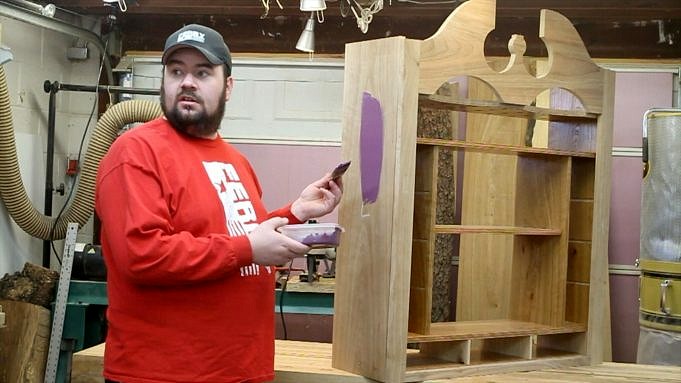Weve spent a week or two in the blog discussing dovetails. I couldn’t pass up the chance to tell a story about dovetails (and never knowing when it might surface again). Here is my tale on dovetails.
When I began making furniture I hated dovetails. Yes its true. I didnt understand how to cut them; I did, however, know that knowledgeable customers wanted to see them.
I purchased a dovetail-jig, and decided that the Jig would be my method. I used the jig when needed, all the time cursing the blessed joint. Because of the jig, or how I was using it, I wasted material. To allow the solid-wood base to move, I made the drawer drawer backs equal in width to the drawer sides.
To remove large amounts of waste material, use a Forstner bit. This will reduce the time required to complete pins in half blind dovetails.
The jig was also lacking in a few areas. It was too difficult to make half blind dovetails due to the long setup time. Being the think outside the box guy I am, I devised a plan. I would mill the material to make my drawers at? I would mill the material for my drawers at? thickness, then make the through dovetail around all corners. Then glue another? of material on the front to create a half-blind look for the drawer fronts. It worked for a while, until a customer noticed and asked about it. I felt woodworking weak.
The problem that led me to hand-cut dovetails was when I was building a tall chest. I had the case sides ready to dovetail and they were through dovetails so the jig was pulled into action.
I attached the jig to a wooden box to work on the sides of the case. This elevated the height to which it could be used during normal usage. The box was placed on top of two 5-gallon buckets, and then the whole setup was stacked on my bench. All that to get a 165 cm-tall chest case side into the jig for dovetails. It gets even better!
Once I was satisfied with the settings, I loaded my piece into the jig. Then I started cutting while standing on a stepladder three steps higher. As I reached the third finger spacing on the jig, something moved. It was impossible for me to match the work when I reversed it to make the tails section. I stopped and pulled the work piece out of the jig. I then removed the first? I have plenty of material left to work with.
An angled platform jig, set to match the layout lines, used at the band saw allows you to leave the saws table square to the blade. To change the angle, reverse the jig.
My customer didnt know it, but his chest had just gotten shorter.
I pulled the panel from the jig, pulled the jig off the wooden box and down from the two buckets then carried the jig to my basement knowing that from this point on, I was going to hand cut any dovetails made in my shop. To this day, that jig sits in my basement, covered in dust, waiting for a reprieve. Its not going to happen!
Three years ahead. I hand cut all the tails and pins. Im also struggling each and every time drawers are scheduled in my day. I actually looked for projects without drawers. You know your customers. They want what they want and I had one who wanted a high chest of drawers , a highboy. An 11 drawer highboy!
I pushed off the inevitable as long as possible. I was confronted with dovetails the next day. The chest was complete , as far as it could be without any drawers , and all the drawer parts were ready. There were no excuses, I had to dovetail.
The next morning, I was driving to the shop when I felt an epiphany. Id been building furniture long enough that I shouldnt have problems with dovetails. It was crazy not being comfortable with this classic joint. Right then I crossed the line; I resolved I would be Master of the Dovetail by days end.
Squirreled away in the shop with no interruptions, I buried my head in the task at hand. Cutting. Chopping. Chiseling. When the day was over I had dovetailed the entire set of drawers , they were the best dovetails Id ever created. It was obvious to me that if you can see it, it is possible to be it.
I know that sounds like mumbo jumbo, but its true. I have never looked back. You too can cut dovetails by hand. Its a matter of following steps. This blog has shown you the progression that can be made. Do it and believe you can do it.
Removing the waste with a jigsaw, while not cutting the scribe line, allows you to set the chisel directly at the scribe line and pare to that line easily.
Now I spend time trying to figure ways to speed up the dovetail process. These photos show how to dovetail faster without losing the hand-cut look. But first understand the basics and then go from there.



